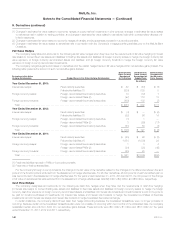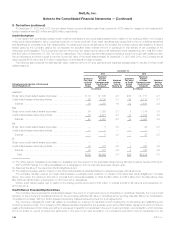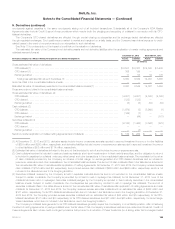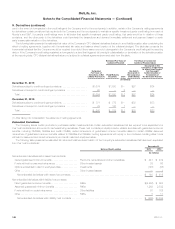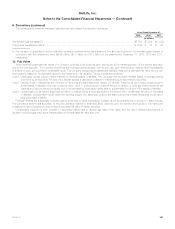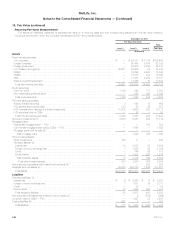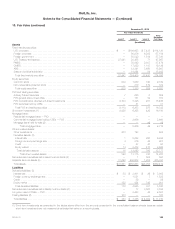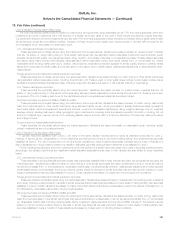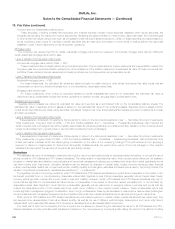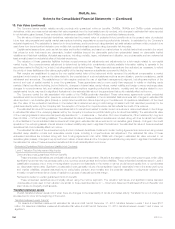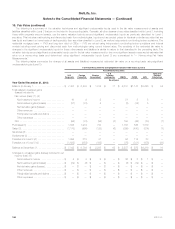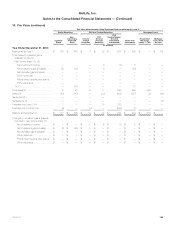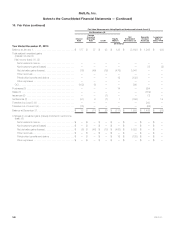MetLife 2013 Annual Report Download - page 159
Download and view the complete annual report
Please find page 159 of the 2013 MetLife annual report below. You can navigate through the pages in the report by either clicking on the pages listed below, or by using the keyword search tool below to find specific information within the annual report.
MetLife, Inc.
Notes to the Consolidated Financial Statements — (Continued)
10. Fair Value (continued)
Level 2 Valuation Techniques and Key Inputs:
This level includes securities priced principally by independent pricing services using observable inputs. FVO and trading securities, short-term
investments and other investments within this level are of a similar nature and class to the Level 2 fixed maturity securities and equity securities.
Contractholder-directed unit-linked investments reported within FVO and trading securities include mutual fund interests without readily determinable
fair values given prices are not published publicly. Valuation of these mutual funds is based upon quoted prices or reported NAV provided by the
fund managers, which were based on observable inputs.
U.S. corporate and foreign corporate securities
These securities are principally valued using the market and income approaches. Valuations are based primarily on quoted prices in markets
that are not active, or using matrix pricing or other similar techniques that use standard market observable inputs such as benchmark yields,
spreads off benchmark yields, new issuances, issuer rating, duration, and trades of identical or comparable securities. Privately-placed securities
are valued using matrix pricing methodologies using standard market observable inputs, and inputs derived from, or corroborated by, market
observable data including market yield curve, duration, call provisions, observable prices and spreads for similar publicly traded or privately traded
issues that incorporate the credit quality and industry sector of the issuer, and in certain cases, delta spread adjustments to reflect specific credit-
related issues.
Foreign government and state and political subdivision securities
These securities are principally valued using the market approach. Valuations are based primarily on matrix pricing or other similar techniques
using standard market observable inputs, including a benchmark U.S. Treasury yield or other yields, issuer ratings, broker-dealer quotes, issuer
spreads and reported trades of similar securities, including those within the same sub-sector or with a similar maturity or credit rating.
U.S. Treasury and agency securities
These securities are principally valued using the market approach. Valuations are based primarily on quoted prices in markets that are not
active, or using matrix pricing or other similar techniques using standard market observable inputs such as a benchmark U.S. Treasury yield curve,
the spread off the U.S. Treasury yield curve for the identical security and comparable securities that are actively traded.
Structured securities comprised of RMBS, CMBS and ABS
These securities are principally valued using the market and income approaches. Valuations are based primarily on matrix pricing, discounted
cash flow methodologies or other similar techniques using standard market inputs, including spreads for actively traded securities, spreads off
benchmark yields, expected prepayment speeds and volumes, current and forecasted loss severity, rating, weighted average coupon, weighted
average maturity, average delinquency rates, geographic region, debt-service coverage ratios and issuance-specific information, including, but not
limited to: collateral type, payment terms of the underlying assets, payment priority within the tranche, structure of the security, deal performance
and vintage of loans.
Common and non-redeemable preferred stock
These securities are principally valued using the market approach. Valuations are based principally on observable inputs, including quoted
prices in markets that are not considered active.
Level 3 Valuation Techniques and Key Inputs:
In general, securities classified within Level 3 use many of the same valuation techniques and inputs as described previously for Level 2.
However, if key inputs are unobservable, or if the investments are less liquid and there is very limited trading activity, the investments are generally
classified as Level 3. The use of independent non-binding broker quotations to value investments generally indicates there is a lack of liquidity or a
lack of transparency in the process to develop the valuation estimates, generally causing these investments to be classified in Level 3.
FVO and trading securities and short-term investments within this level are of a similar nature and class to the Level 3 securities described below;
accordingly, the valuation techniques and significant market standard observable inputs used in their valuation are also similar to those described
below.
U.S. corporate and foreign corporate securities
These securities, including financial services industry hybrid securities classified within fixed maturity securities, are principally valued using the
market approach. Valuations are based primarily on matrix pricing or other similar techniques that utilize unobservable inputs or inputs that cannot
be derived principally from, or corroborated by, observable market data, including illiquidity premium, delta spread adjustments to reflect specific
credit-related issues, credit spreads; and inputs including quoted prices for identical or similar securities that are less liquid and based on lower
levels of trading activity than securities classified in Level 2. Certain valuations are based on independent non-binding broker quotations.
Foreign government and state and political subdivision securities
These securities are principally valued using the market approach. Valuations are based primarily on independent non-binding broker quotations
and inputs, including quoted prices for identical or similar securities that are less liquid and based on lower levels of trading activity than securities
classified in Level 2. Certain valuations are based on matrix pricing that utilize inputs that are unobservable or cannot be derived principally from,or
corroborated by, observable market data, including credit spreads.
Structured securities comprised of RMBS, CMBS and ABS
These securities are principally valued using the market and income approaches. Valuations are based primarily on matrix pricing, discounted
cash flow methodologies or other similar techniques that utilize inputs that are unobservable or cannot be derived principally from, or corroborated
by, observable market data, including credit spreads. Below investment grade securities and sub-prime RMBS included in this level are valued
based on inputs including quoted prices for identical or similar securities that are less liquid and based on lower levels of trading activity than
securities classified in Level 2. Certain of these valuations are based on independent non-binding broker quotations.
MetLife, Inc. 151



